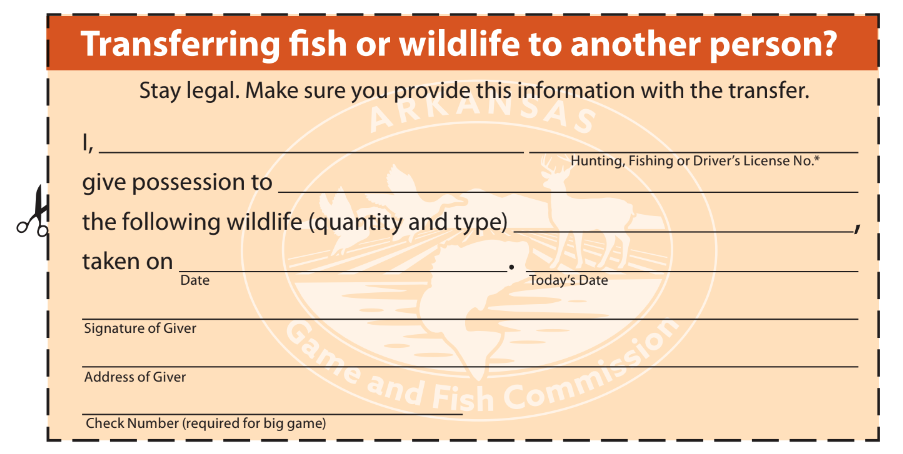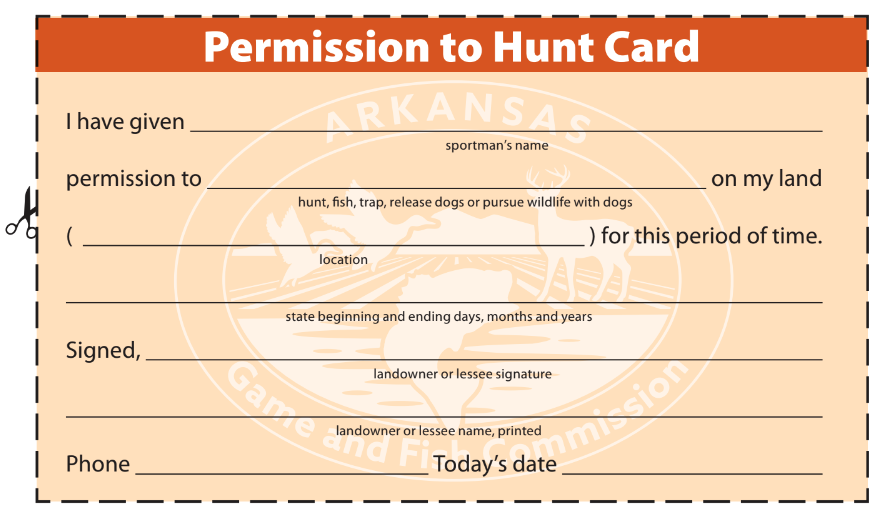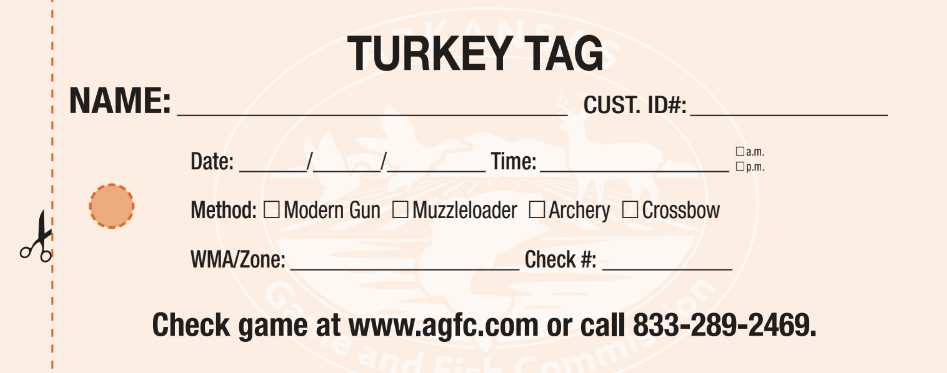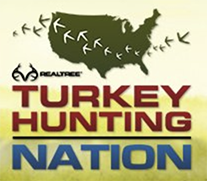Turkey Hunting Regulations
New This Year
- Penalty for baiting wild turkeys was increased to a Class 3 violation.
- Turkey hunting on Petit Jean River and Cypress Bayou WMAs is open to turkey hunting by permit only.
- Additional permit hunt opportunities have been added to Devil’s Eyebrow Natural Area, Beryl Anthony Lower Ouachita, Cypress Bayou, McIlroy Madison County and Petit Jean River WMAs.
- Hybrid permit turkey hunts were added at Longview Saline, Trusten Holder and Warren Prairie WMAs. The first three days are hunting by permit only. Day
four through the remainder of the season the hunting is open to all license holders. - The hybrid permit hunt on Sylamore WMA will be permit only for the first three days of the season, with day four through the remainder of the season open to all license holders.
- Ozark National Forest WMA has been dissolved into its surrounding co-op WMAs. Refer to the AGFC interactive map on the AGFC’s webpage (www.agfc.com) for WMA boundaries.
What Is a Legal Turkey?
A turkey may be considered legal under the following rules:
A legal turkey is an adult gobbler. Only hunters 6-15 years old may harvest one jake as part of their two-bird limit during the season (including the youth hunt).
How to Identify an Adult Gobbler vs. Hen Turkey
A beard alone does not provide verification of a legal turkey. See below.
Adult Gobbler (Male) Characteristics
See below for how to identify a jake (juvenile male).
- Breast feathers with black tips.
- Approximately twice the size of a female.
- Head and major caruncles at base of neck are vibrant shades of red, blue and white.
- Beards are usually greater than 6 inches in length.
- Spurs usually greater than 1/2 inch.
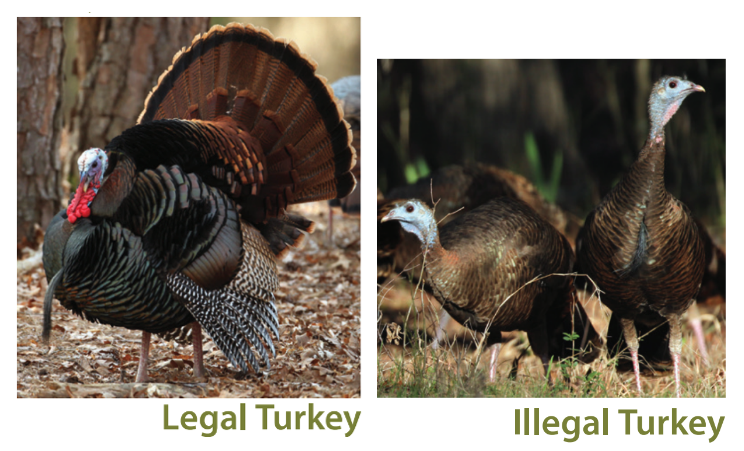
Hen (Female) Characteristics
- Tips of breast feathers are brown or buff colored. Browner or drab in appearance.
- Typically half to two-thirds the size of an adult gobbler or jake.
- Head is primarily blue, with light feathering. Small minor caruncles can be red but are substantially smaller than the major caruncles on males.
• Typically do not have a beard, but 10-12% of females may have a beard.
• Spurs absent.
How to Identify a Jake Turkey
A jake is a male turkey with all these characteristics:
- Outermost wing feathers lack white barring all the way to the tip.
- The central tail feathers are longer than the rest.
- The beard is 6 inches or shorter.
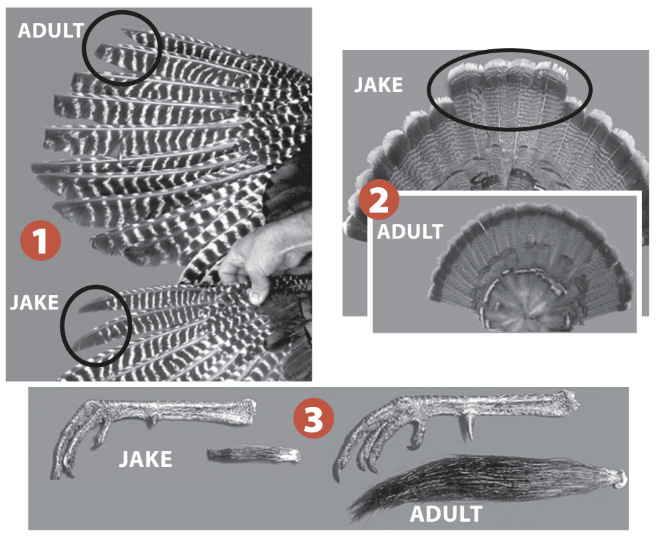
An adult gobbler is a male turkey with at least one of the following characteristics:
- Wing feathers have white barring all the way to the tip.
- Tail feathers are the same length.
- The beard is longer than 6 inches.
Turkey Regulations Summary
- Only shotguns (10 gauge and smaller) and archery equipment (including crossbows) are legal for turkey hunting. Shot larger than No. 2 common shot is
prohibited. - Shooting a turkey from a boat is illegal.
- Turkeys may not be taken from 30 minutes after sunset until 30 minutes before sunrise.
- Hunting within 100 feet of the center of a city, county, state or federally maintained road or any open road on a WMA or NWR is illegal. Check the
area notes of your WMA or NWR for exceptions. - Firearms must be unloaded and cased while being transported by boat from 30 minutes after sunset until 30 minutes before sunrise.
- Turkeys may not be hunted with the use of traps, snares, nets, hooks, explosives, dogs or live decoys. Hunters may not possess electronic or mechanically
powered or driven callers. - During youth turkey hunts, coyote and bobcat hunting is open only to youth hunters.
- Hunting or shooting across the main west levee of the Mississippi or Arkansas rivers from the Louisiana-Arkansas state line to the intersection of
Arkansas Highway 11 is illegal. - Hunters must be at least 6 years old to harvest a wild turkey.
- Releasing domestically reared turkeys into the wild is illegal.
- Capturing wild turkeys or collecting their eggs is illegal.
- Wild turkeys may not be hunted over bait. An area is considered baited if any food (including shelled, shucked or unshucked corn, chops, wheat or other
feed that could serve as a lure or attractant for wildlife) is present or has been present in the last 10 days. (An area is considered baited for 10 days
following complete removal of the bait.) A hunter is liable for a baiting violation if he or she knows, or reasonably should know, that the area is or has
been baited, even following complete removal of bait. There is no set distance from a baited site that a hunter may shoot a turkey. - Each WMA is a separate zone for which the Commission may establish and apply hunting regulations. Private land that is completely surrounded by WMA land is subject to the same hunting season dates, hunting hours, bag limits and hunting permits as the surrounding WMA.
EXCEPTION:
Private land completely surrounded by National Wildlife Refuge or Arkansas Natural Heritage Commission land is subject to the same hunting season dates, hunting hours, bag limits and hunting permits as the surrounding or nearest adjacent state management zone, plus any federal regulations pertaining to NWR or ANHC.
Private Property and Residences
Hunting Near a Residence
Hunters lawfully present through ownership or lease agreement may hunt on their own property, regardless of distance to another person’s residence.
However, all other hunters using firearms within 150 yards of a residence or using archery equipment within 50 yards of a residence must have written permission from the owner or occupant of that residence.
Hunting on Private Property
Written permission (see example below) from the landowner or leaseholder is required before hunting, fishing, trapping or releasing hunting dogs or pursuing wildlife with dogs on private property.
Written permission is not required if the person hunting is a relative (spouse, parent, child, sibling, uncle, aunt, son or daughter-in-law, niece, nephew, grandchild, or grandparent of owner) of the landowner or leaseholder and permission can be verified.
Turkey Tagging and Checking Requirements
Checking a Turkey by Phone or Online
Use the zone map for turkeys harvested on private land. Use the zone map on pages 22-23 for turkeys harvested on public lands.
Hunters under 16 must have a Customer ID number available free at agfc.com.
Option 1: Immediately upon harvest (before moving turkey), check turkey via www.agfc.com, the AGFC mobile app or by calling 877-731-5627.
Option 2: Follow both steps below:
Step 1. Fill out a game tag from your license or the one provided below. Complete all information, except Check #, legibly and in ink. A game tag also may be created from any material that includes the hunter’s name, customer ID number and the date, time and zone of harvest. Fasten the tag to the leg of the turkey.
Step 2. Check turkey via www.agfc.com, the AGFC mobile app or by calling 877-731-5627 within 12 hours of harvest. (Note check number on game tag.)
Checked game does not require a tag as long as the turkey remains in the hunter’s immediate possession. If the animal is left at a processor or other facility before point of final storage, harvest information reflecting the name, address, species, date taken and check confirmation number must remain with all portions
Entrails may be removed, but evidence of the animal’s sex must remain until checked.
No turkey may be transported across state lines before being checked.
If you choose to give away all or a portion of your game after it has been checked, you must use a game transfer form.
Transferring Wildlife
Transferring fish or wildlife to another person?
If you give all or part of your game to another person, you must give that person all information listed on the sample tag (below).
Hunting Camp and Commercial Processing Records Requirements
Hunting camps, commercial butchers, processors, cold storage facilities, fur buyers and taxidermists must maintain legible records of all information listed on the sample tag for all wildlife and parts thereof in their possession. These records must be maintained and available for one year from the date taken.
